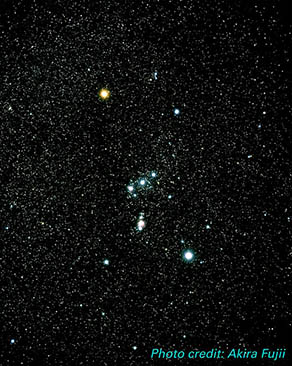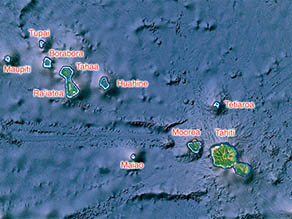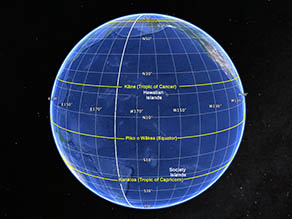 |
 |
 |
|||||
|
Haumea:
“There’s a story of earth-mother Haumea, Wākea (sky father) as humans on the Earth here in He‘eia, in Kāne‘ohe,” Lilikalā tells us. “The name of the mountain, Ka‘iwipo‘o, means the ‘bone of the head,’ ‘the skull of the head.’ That’s the name of that mountain. And then you come through Ha‘ikū, which is still part of He‘eia, and you come up to Keahiakahoe. Keahiakahoe, ‘the fire of Hoe,’ is a dividing line between He‘eia and Kāne‘ohe. “And then as you come down from Keahiakahoe towards where the Likelike Highway is, there’s a little bump in the mountain with a dip in-between, and that’s called Kilohana. If you measure from the temple Kawa‘ewa‘e in Kāne‘ohe to Kilohana, it’s exactly east-west, 90 degrees east. That’s a spot where Wākea (Orion) meets with earth mother Haumea. That’s a marker for when the sun goes through equinox, right through there. “Paoa is the name of a priesthood from Ra‘iātea down by Tahiti. If you go to Tahiti today and you sail northwest for a day, you hit Ra‘iātea. It’s about 150 miles away. Ra‘iātea has a sacred temple, Taputapuatea, which is the most important temple in Eastern Polynesia. Our religion in Hawai‘i comes from there. “In the Ra‘iātea cosmogonic genealogy, the he‘e—the octopus—is in a shell floating in the universe all by himself. One day, he can’t fit in that shell anymore. He’s grown too big, so he cracks it open, and he calls out, and there’s nobody there, only him. So, he turns half of the shell into the land of Ra‘iātea, and the other part of the shell into the sky above Ra‘iātea, and then he calls forth the gods. “So Kanaloa, the he‘e—in Tahiti it’s called Ta‘aroa—is the creator god. He wills the other major akua or atua—the divinities or divine elements—to come into being, and they do. One of them is a female that he sleeps with, and he has a child called Atea. In Hawai‘i, we call Atea Wākea—sky-father Orion. But in Ra‘iātea, Atea is born as a female. Later on, she changes her sex and becomes male. So, she’s a male in Hawai‘i, but in Ra‘iātea she’s female. “While she’s female, she has a male lover and she has a child that is born as a shapeless mass. She carves him into the god of beauty, and that’s the god Tane or Kāne who becomes the god of the sun. So, we have ocean as the parent of the star Orion, and Orion as the parent of the sun. Those three male elements line up with the Polynesian idea of the universe. The tropic of Capricorn in the southern Pacific is the line dedicated to Kanaloa, Ocean; the equator is dedicated to Wākea (Orion), because the first star in the Belt of Orion is exactly 90 degrees east. The sun comes through there at equinox. The top line is dedicated to Kāne, the sun god, that’s the Tropic of Cancer. 
“Those three lines are measured on the temples—that is zero-north. In 2014, I took 13 faculty and students to Tahiti. We went to five different islands. We measured 30 temples in 21 days. A majority were either zero north one wall, or they were diagonal north from one corner to the other corner. So like from the northwest of the southeast corner, exactly zero north. "That means that the other corner, which is northeast, is actually aligned with where the sun rises at equinox. So, equinox is important. We believe equinox in March is the time when you can gain political power. In Hawaiian terms, there’s certain ceremonies that were done that have to do with the gaining of political power on that equinox. It has to be done before you get to summer solstice. “On Tahiti, most of the temples were not aligned zero-north. The Tahitian astronomers tell us, ‘Oh no, they’re for the rising star lines, they’re not for the sun.’ Which is curious, because at Ra‘iātea, at Taputapuatea with the zero-north temple, where they’re measuring the movement of the sun, Kanaloa and Wākea are the great gods. And then Kāne, the grandson of Kanaloa, slips off and becomes the great god of Tahiti, and now oceans and stars are not as important as sun. “It’s the Tahiti folks that come north first to Hawai‘i because we worship the sun most in this area. So in our stories, in our cosmogonic genealogy, Kāne is the older brother of Kanaloa, not the grandson. And then the other male akua come from the south. They come up here and Haumea has interactions with all three of them. “What happens is there’s a split between Tahiti and Ra‘iātea. The Tahiti guys come north first with their idea that Kāne is the most important—the sun god is the most important—and later on the Ra‘iātea guys come with the idea that Kanaloa is more important. Those two things merge in our place names, in our worship, in our arguments between who is more important—sun or ocean—with Haumea, earth mother, sleeping with all three male entities. “She sleeps with Kanaloa and the moon is born, female. All knowledge of moon is female. She sleeps with Wākea—Orion—and Hawaiian Islands and Hawaiian people are born because of our genealogy, so we’re of Orion. “There’s a term, piko-o-Wākea which means the equator. There’s only one star in the universe that actually goes through that—actually, there’s two. There’s one in Aquarius and there’s one in Orion, but Orion looks like sky father. And then she sleeps with Kāne, and Pele and the volcano clan were born. But in Hawai‘i, they don’t fight anymore, they’re all together. “The old name of Ra‘iātea before the split was Hawai‘i. So, the name of Hawai‘i Island comes north to us from Ra‘iātea. The northern island of Ra‘iātea, there’s one lagoon and two islands. They said that the split was formed when Tahiti moved away like a fish. The island just left there and went somewhere else. The top part of the split is ‘Upolu, and that island ‘Upolu and the bottom Hawai‘i are place names in Hawai‘i Island. The northern-most point of Hawai‘i Island is called ‘Upolu. And the great navigator of ‘Upolu is Hilo. So as I looked at the land, I feel like I’m living in the land of Kanaloa.” |
|
|||||
|
Pacific Worlds > He‘eia, O‘ahu > Arrival > Legendary Setting |
||||



